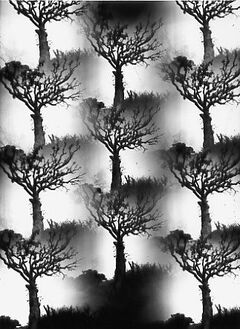From the archive to the History Museum
see German version below
Thomas Kellner's collection goes to Santa Fe
Siegen, Germany. The most comprehensive collection of early works by Siegen's photo artist, Thomas Kellner, is moving to the New Mexico History Museum in Santa Fe, New Mexico, along with the pinhole camera archive. The Pinhole Resource has donated its complete archive of pinhole camera images to the Museum.
In June of this year, Eric Renner, owner of the Pinhole Resource and publisher of the Pinhole Journal, decided along with Co-director Nancy Spencer to donate the collection. The photo archive at the Palace of the Governors contains over 800,000 photographic prints, glass plate negatives and photo post-cards. An extensive specialist library as well as camera constructions by artists also form part of the archive's inventory. At 239 photo images by Thomas Kellner, the Museum now owns the largest Kellner collection worldwide.
Mr. Kellner first worked with pinhole camera technology during his art studies at the University of Siegen. For his thesis, Thomas Kellner photographed the complete former border between the two Germanys with a pinhole camera he had built himself and won the Kodak Best New Talent Award. Already in 1991, Mr. Kellner had initiated the "Zwischenzeit - camera obscura im Dialog" project together with some fellow students. This is when he first met Eric Renner. A lively professional exchange developed for many years to come.
For almost ten years, Thomas Kellner dedicated himself to various themes (Quicksnaps, Dying Nature, Diario Veneziano, 11 Pinhole Works, 19 Pinhole Panoramas, Germany - Looking Outside, Sixtoramas), which he worked on with his self-made camera in always new ways - again and again. Renner published selected images from every new series in the Pinhole Journal and in books. Mr. Kellner's experiments, especially with the multiple pinhole camera and with Venice's architecture in the body of work "Diario Veneziano", formed the basis of his famous architectural tableaus.
"The idea, techniques and visual implementation for a homogenous unity." Mr. Kellner presents us with a world observed through "different eyes". A world full of secrets and unusual views, whose succinct esthetic sense motivate us to look closer. - D. Brudna, 1995 Photonews.
Vom Archiv ins Historische Museum
Vom Archiv ins Historische Museum
Thomas Kellner-Sammlung geht nach Santa Fe
Siegen. Die umfangreichste Sammlung früher Werke des Siegener Fotokünstlers Thomas Kellner zieht mit dem Lochkamera-Archiv aus San Lorenzo in das New Mexico History Museum in Santa Fe. Das Pinhole Resource stiftete dem Museum sein komplettes Archiv von Lochkamera Fotografien.
Im Juni dieses Jahres entschieden sich Eric Renner, Inhaber von Pinhole Resource und Herausgeber des Pinhole Journals, und
Co-Direktorin Nancy Spencer für die Schenkung. Das Foto-Archiv am Palace of the Governors beinhaltet über 800.000 Fotoabzüge, Glasplatten Negative und Foto-Postkarten. Eine umfangreiche Fachbibliothek als auch gesammelte Kamerabauten von Künstlern gehören ebenso zum Archivinventar. Mit 239 Fotoarbeiten von Thomas Kellner verfügt das Museum nun über die größte Kellner-Sammlung weltweit. Thomas Kellner befasste sich zum ersten Mal mit der Lochkamera-Technik während seines Kunst-Studiums an der Universität Siegen. Für seine Abschlussarbeit fotografierte er entlang der gesamt-deutschen Grenze mit einer selbstgebauten Lochkamera und erhielt dafür den Kodak-Nachwuchs-Förderpreis. Bereits im Jahre 1991 initiierte Kellner mit Kommilitonen das Projekt „Zwischenzeit - camera obscura im Dialog“. Zu dieser Zeit lernte er Eric Renner kennen. Über Jahre hinweg entwickelte sich ein reger fachlicher Austausch.
Kellner widmete sich über fast zehn Jahre verschiedenen Themen (Quicksnaps, Dying Nature, Diario Veneziano, 11-Loch-Arbeiten, 19-Loch-Panoramen, Deutschland – Blick nach Draußen, Sixtoramen), die er mit seinen immer wieder neuen selbstgebauten Kameras künstlerisch bearbeitete. Von jeder neuen Serie veröffentlichte Renner ausgewählte Fotos im Pinhole Journal und in Büchern. Kellners Experimente, speziell mit den Mehrlochkameras und mit der Architektur Venedigs in der Werkgruppe „Diario Veneziano“, waren die Grundlagen für seine bekannten Architekturtableaus.
„Idee, Technik und visuelle Umsetzung bilden eine homogene Einheit. Kellner präsentiert uns eine durch „andere Augen“ beobachtete Welt. Eine Welt voller Geheimnisse und ungewohnter Blicke, deren prägnante Ästhetik zum genauen Hinsehen animiert." - D. Brudna, 1995 Photonews









